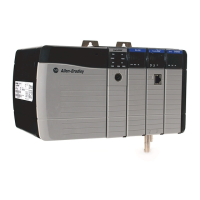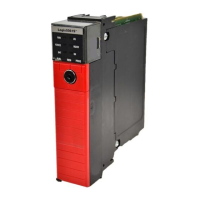Common Attributes for Advanced Process Control and Drives Instructions
Rockwell Automation Publication 1756-RM006K-EN-P - November 2018 539
S:V
Overflow flag
The controller sets the overflow flag when:
• The result of a math operation results in an overflow.
For example, adding 1 to a SINT generates an overflow when the
value goes from 127 through -128.
• The destination tag is too small to hold the value.
For example, if you try to store the value 123456 to a SINT or INT
tag.
Use the overflow flag to verify the result of an operation is still in
range.
If the data being stored is a string type, S:V is set if the string is too
large to fit into the destination tag.
Tip: If applicable, set S:V with an OTE or OTL instruction.
Click Controller Properties > Advanced tab > Report Overflow
Faults to enable or disable reporting overflow faults.
If an overflow occurs while evaluating an array subscript, a minor
fault is generated and a major fault is generated to indicate the index
is out of range.
The controller sets the
overflow flag when:
• The result of a math
operation results in
an overflow.
For example, adding
1 to a SINT
generates an
overflow when the
value goes from
127…-128.
• The destination tag
is too small to hold
the value.
For example, if you
try to store the value
123456 to a SINT or
INT tag.
Use the overflow flag to
check that the result of
an operation is still in
range.
A minor fault is
generated anytime an
overflow flag is set.
Tip: If applicable,set S:V
with an OTE or OTL
instruction.\
S:C
Carry flag
The controller sets the carry flag when the result of a math operation
resulted in the generation of a carry out of the most significant bit.
Only the ADD and SUB instructions, and not the + and – operators,
with integer values affect this flag.
The controller sets the
carry flag when the
result of a math
operation resulted in
the generation of a
carry out of the most
significant bit.
S:MINOR
Minor fault flag
The controller sets the minor fault flag when there is at least one
minor program fault.
Use the minor fault tag to test if a minor fault occurred. This bit only
triggers by programming faults, such as overflow. It is not triggered
by a battery fault. The bit clears at the beginning of every scan.
Tip: If applicable, explicitly set S:MINOR with an OTE or OTL
instruction.
The controller sets the
minor fault flag when
there is at least one
minor program fault.
Use the minor fault flag
to test if a minor fault
occurred and take
appropriate action. This
bit is triggered only by
programming faults,
such as overflow. It is
not triggered by a
battery fault. The bit
clears at the beginning
of every scan.
Tip: If applicable,
explicitly set S:MINOR
with an OTE or OTL
instruction.
